Comparative Biotic Monitoring of a Modified Denil Fishway and a Pool and Weir Fishway on a Small Tributary in the Upper Trout Region
Abstract
1. Introduction
2. Methodology
2.1. Study Area
2.1.1. Modified Denil Fishway
2.1.2. Pool and Weir Fishway (PWF)
2.2. Abiotic Principles
2.3. Biotic Principles
- Qualitative upstream migration (fish species and life stages);
- Quantitative upstream migration (abundance).
2.3.1. Phase I: Bullhead Test in the Modified Denil Fishway (MDF)
2.3.2. Phase II: Three-Day Sampling Cycles
2.3.3. Phase III: Daily Exchange of Cone Traps
2.3.4. Statistical Analyses
3. Results and Discussion
3.1. Abiotics
3.2. Biotics
3.2.1. Bullhead Test in the Modified Denil Fishway (MDF) (Phase I)
3.2.2. Qualitative and Quantitative Upstream Migration of Brown Trout in the Monitoring Phases (Phases II and III)
4. Patents
Author Contributions
Funding
Data Availability Statement
Conflicts of Interest
References
- European Parliament and Council of 23 October 2000; Directive 2000/60/EC of the European Parliament and the Council Established a Framework for the Community Action in the Field of Water Policy, for Short, EU Water Framework Directive (WFD). Available online: https://eur-lex.europa.eu/legal-content/EN/TXT/?uri=celex%3A32000L0060 (accessed on 5 June 2023).
- Austrian Water Rights Act; Österreichisches Wasserrechtsgesetz: Vienna, Austria, 1959.
- Schletterer, M.; Monai, B.; Seidl, G.; Mayrhofer, B.; Mitterlehner, C.; Strasser, B.; Albrecht, W.; Struska, N.; Zeiringer, B.; Mader, H. Sonderlösungen zum Fischaufstieg—Stand in Österreich. WasserWirtschaft 2023, 2–3, S35–S40. [Google Scholar] [CrossRef]
- BMLRT (Bundesministerium für Landwirtschaft, Regionen und Tourismus). Leitfaden zum Bau von Fischaufstiegshilfen 2021; BMLRT: Vienna, Austria, 2021; 224p. [Google Scholar]
- Denil, G. Les Échelles à Poissons et Leur Application aux Barrages de Meuse et d’Ourthe; Annales des travaux publics de Belgique Série II/XIV; AbeBooks: Victoria, BC, Canada, 1909; Volume 66, pp. 253–395. [Google Scholar]
- Rajaratnam, N.; Katopodis, C. Hydraulic of Denil Fishways. J. Hydraul. Eng. 1984, 110, 1219–1233. [Google Scholar] [CrossRef]
- DWA (Deutsche Vereinigung für Wasserwirtschaft). Fischaufstiegsanlagen und Fischpassierbare Bauwerke—Gestaltung, Bemessung, Qualitätssicherung; DWA: Hennef, Germany, 2014; 340p. [Google Scholar]
- Krüger, F. Denil-Fischpässe. Wasserwirtsch. Wassertech. 1994, 94, 24–32. [Google Scholar]
- McLeod, A.M.; Nemenyi, P. An Investigation of Fishways; University of Iowa Studies in Engineering, Bulletin: Iowa City, IA, USA, 1941; Volume 24, 72p. [Google Scholar]
- Fulton, L.A.; Gangmark, H.A.; Bair, S.H. Trial of Denil-Type Fish Ladder on Pacific Salmon. No. 99; US Department oft he Interior, Fish and Wildlife Service: Washington, DC, USA, 1953; 15p. [Google Scholar]
- Larinier, M.; Baffle Fishways. Bulletin Francais de la Peche et de la Pisciculture. No. 364, 2002; pp. 83–101. Available online: https://www.researchgate.net/publication/27335345_Baffle_fishways (accessed on 5 June 2023).
- Larinier, M. Environmental issues, dams and fish migration. Dams, fish and fisheries. In Opportunities, Challenges and Conflict Resolution; FAO Fisheries Technical Paper, No. 419; FAO: Rome, Italy, 2001; 166p. [Google Scholar]
- Schmetterling, D.A.; Pierce, R.W.; Liermann, B.W. Efficacy of Three Denil Fish Ladders for Low-Flow Fish Passage in Two Tributaries to the Blackfoot River, Montana. N. Am. J. Fish. Manag. 2002, 22, 929–933. [Google Scholar] [CrossRef]
- Baumgartner, L.J. A Preliminary Assesment of Fish Passage through a Denil Fishway on the Edward River in Australia; MDBC Project No. MD524; NWS Department of Primary Industries: Gosford, NSW, Australia, 2006. [Google Scholar]
- Noonan, J.M.; Grant, J.W.A.; Jackson, C.D. A quantitative assessment of fish passage efficiency. Fish Fish. 2012, 13, 450–464. [Google Scholar] [CrossRef]
- Bunt, C.M.; Castro-Santos, T.; Haro, H. Performance of fish passage structures at upstream barriers to migration. River Res. Applic. 2012, 28, 457–478. [Google Scholar] [CrossRef]
- Bunt, C.M.; Castro-Santos, T.; Haro, H. Reinforcement and validation of the Analyses and Conclusion related to fishway evaluation data from Bunt et al.: Performance of fish passage structures at upstream barriers to migration. River Res. Appl. River Res. Applic. 2016, 32, 2125–2137. [Google Scholar] [CrossRef]
- Mallen-Cooper, M.; Stuart, I.G. Optimising Denil fishways for passage of small and large fishes. Fish. Manag. Ecol. 2007, 14, 61–71. [Google Scholar] [CrossRef]
- Schneider, J.; Dorfmann, C. Denil Fischpass. Model Test. Graz University of Technology. Institute of Hydraulic Engineering and Water Resources Management, Graz, Austria. Unpublished report. 2016; 54p. [Google Scholar]
- Seidl, G.; Schneider, J.; Dorfmann, C. Der modifizierte, sohloffene Denil-Pass—Renaissance einer kostensparenden Fischaufstiegsanlage. WasserWirtschaft 2021, 2–3, S10–S17. [Google Scholar]
- Zach, S. Feldversuch eines Adaptierten Denil-Fischpasses im Epipotamal—Biotisches und Abiotisches Monitoring einer Fischaufstiegsanlage. Master’s Thesis, University of Natural Resources and Applied Life Sciences, Vienna, Austria, 2018; 111p. [Google Scholar]
- Woschitz, G.; Eberstaller, J.; Schmutz, S. Mindestanforderungen bei der Überprüfung von Fischmigrationshilfen und Bewertung der Funktionsfähigkeit. In RL 1/2003 der Fachgruppe Fischereisachverständige beim Österreichischen Fischereiverband; Österreichischer Fischereiverband: Vienna, Austria, 2003; ISBN 3-902-399-02-3. [Google Scholar]
- Utzinger, J.; Roth, C.; Armin, P. Effects of environmental parameters on the distribution of bullhead Cottus gobio with particular consideration of the effects of obstructions. J. Appl. Ecol. 1998, 35, 882–892. [Google Scholar] [CrossRef]
- Katopodis, C. Introduction to Fischway Design; Freshwater Institute: Winnipeg, MB, Canada, 1992; 67p. [Google Scholar]
- Clay, C.H. Design of Fishways an Other Fish Facilities, 2nd ed.; Lewis Publishers: Boca Raton, FL, USA, 1995; 25p. [Google Scholar]
- Ead, S.A.; Katopodis, C.; Sikora, G.J.; Rajaratnam, N. Flow regimes and structure of pool and weir fishways. J. Environ. Eng. Sci. 2004, 3, 379–390. [Google Scholar] [CrossRef]
- Seidl, G.; Haslwanter, M.; Schneider, J. Der Technische Beckenpass—Eine Hydraulische und Biotische Gegenüberstellung mit Konventionellen Beckenartigen Fischaufstiegshilfen; Österr Wasser-und Abfallw: Vienna, Austria, 2022. [Google Scholar] [CrossRef]
- Available online: www.r-project.org (accessed on 5 June 2023).
- Tauber, M.M. Maßnahmen zur Steigerung der Stromerzeugung an Wasserkraftanlagen bei Gleichzeitiger Erfüllung der Richtlinie 2009/28 EG (Erneuerbaren Richtlinie) und 2000/60/EG (Wasserrahmenrichtlinie). Ph.D. Thesis, University of Natural Resources and Applied Life Sciences, Vienna, Austria, 2011; 361p. [Google Scholar]
- Marriner, B.A.; Baki, A.B.M.; Zhu, D.Z.; Cooke, S.J.; Katopodis, C. The hydraulics of a vertical slot fishway: A case study on the multi-species Vianney-Legendre fishway in Quebec, Canada. Ecol. Eng. 2016, 90, 190–202. [Google Scholar] [CrossRef]
- Quaranta, E.; Katopodis, C.; Comoglio, C. Effects of bed slope on the flow field of vertical slot fishways. River Res. Appl. 2019, 35, 656–668. [Google Scholar] [CrossRef]
- Tudorache, C.; Viaene, P.; Blust, R.; Vereecken, H.; De Boeck, G. A comparison of swimming capacity and energy use in seven European freshwater fish species. Ecol. Freshw. Fish 2008, 17, 284–291. [Google Scholar] [CrossRef]
- Clough, S.C.; Turnpenny, A.W.H. Swimming Speeds in Fish: Phase 1. R&D Technical Report W2-026/TRI; Environment Agency: Bristol, UK, 2001; 94p, ISBN 1-85705-417-2. [Google Scholar]
- Schwalme, K.; Mackay, W.C.; Lindner, D. Suitability of Vertical Slot and Denil Fishways for Passing North-Temperate, Nonsalmonid Fish. Can. J. Fish. Aquat. Sci. Sci. 1985, 42, 1815–1822. [Google Scholar] [CrossRef]
- Linløkken, A. Efficiency of fishways and impact of dams on the migration of Grayling and Brown trout in the Glomma River system, South-eastern Norway. Regul. Rivers Res. Manag. 1993, 8, 145–153. [Google Scholar] [CrossRef]
- Jensen, A.; Aas, P. Migration of a fast-growing population of brown trout (Salmo trutta L.) through a fish ladder in relation to water flow and water temperature. Regul. Rivers Res. Manag. 1995, 10, 217–228. [Google Scholar] [CrossRef]
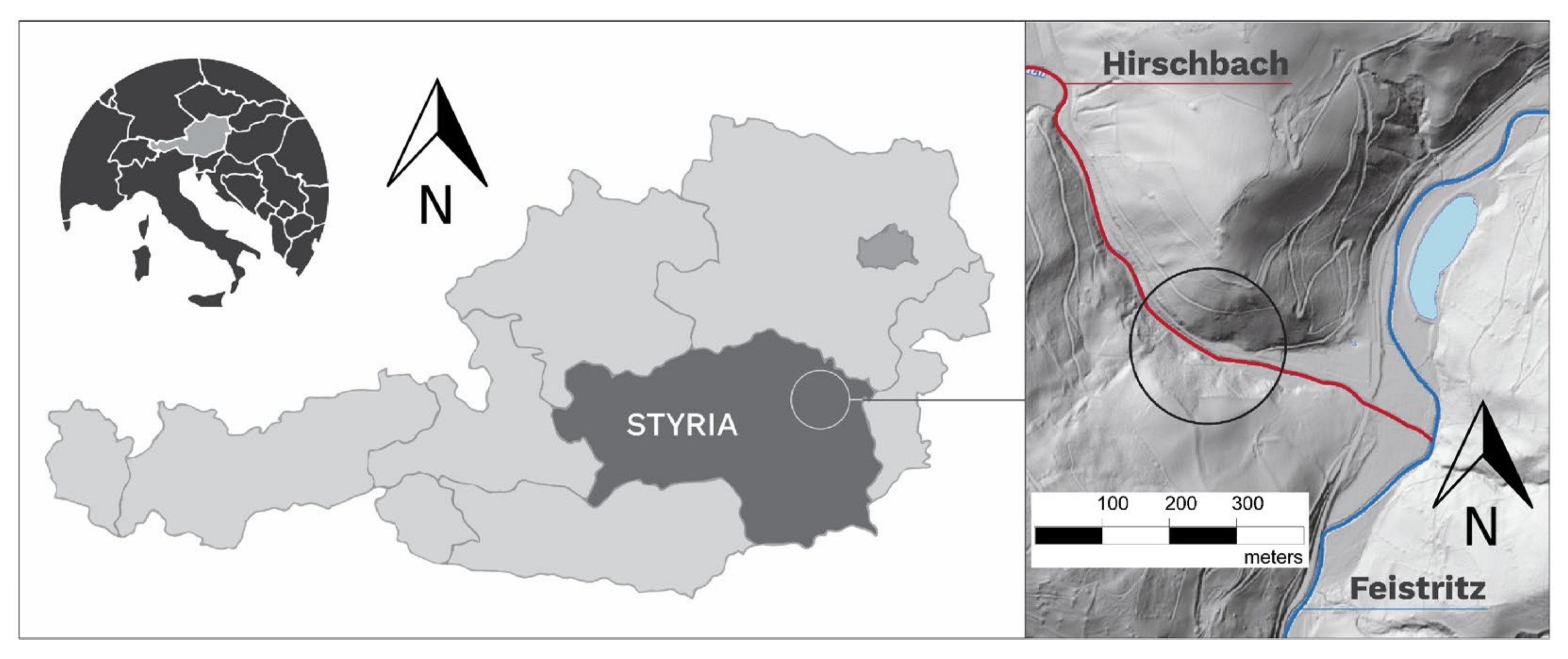


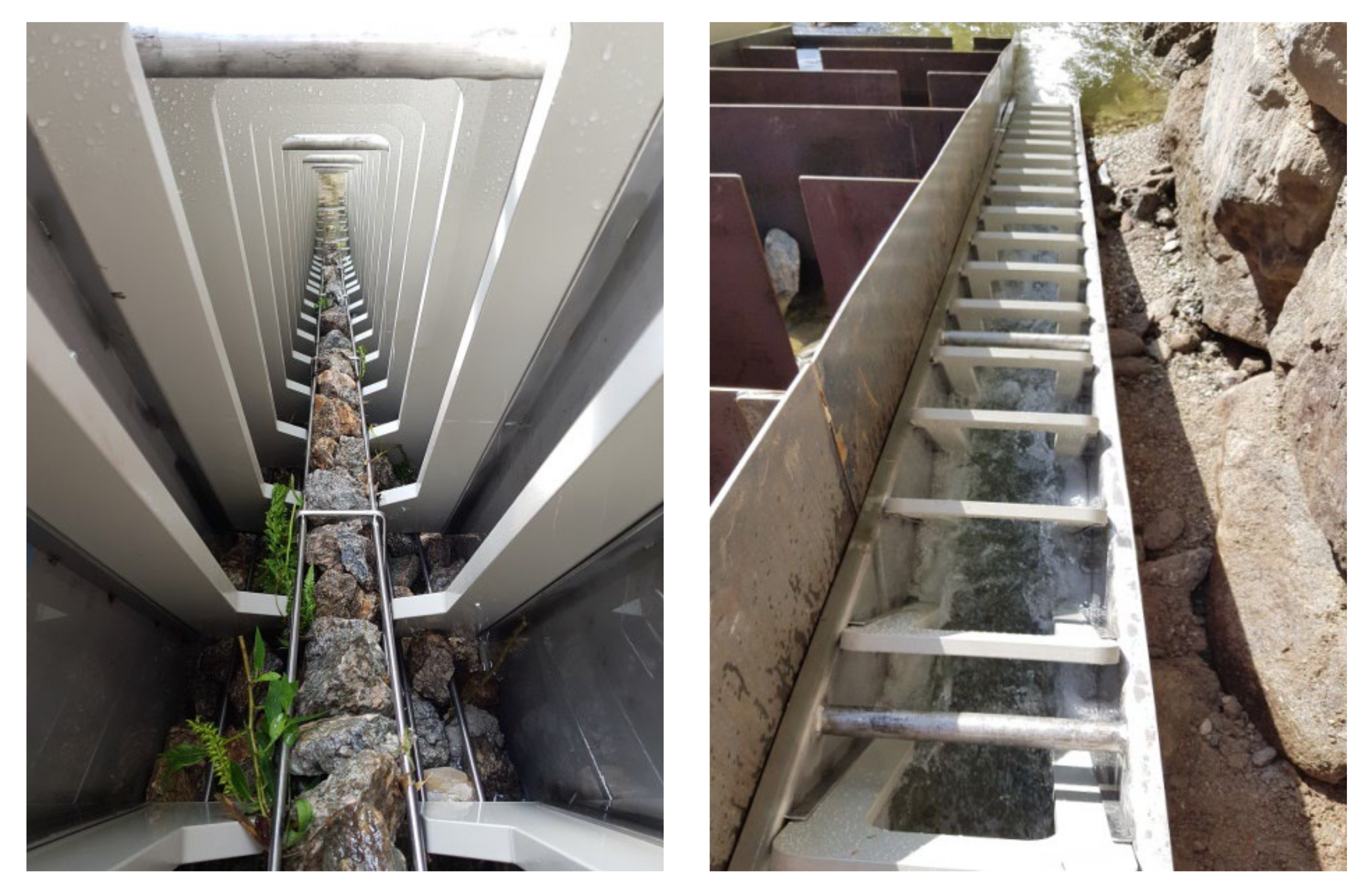
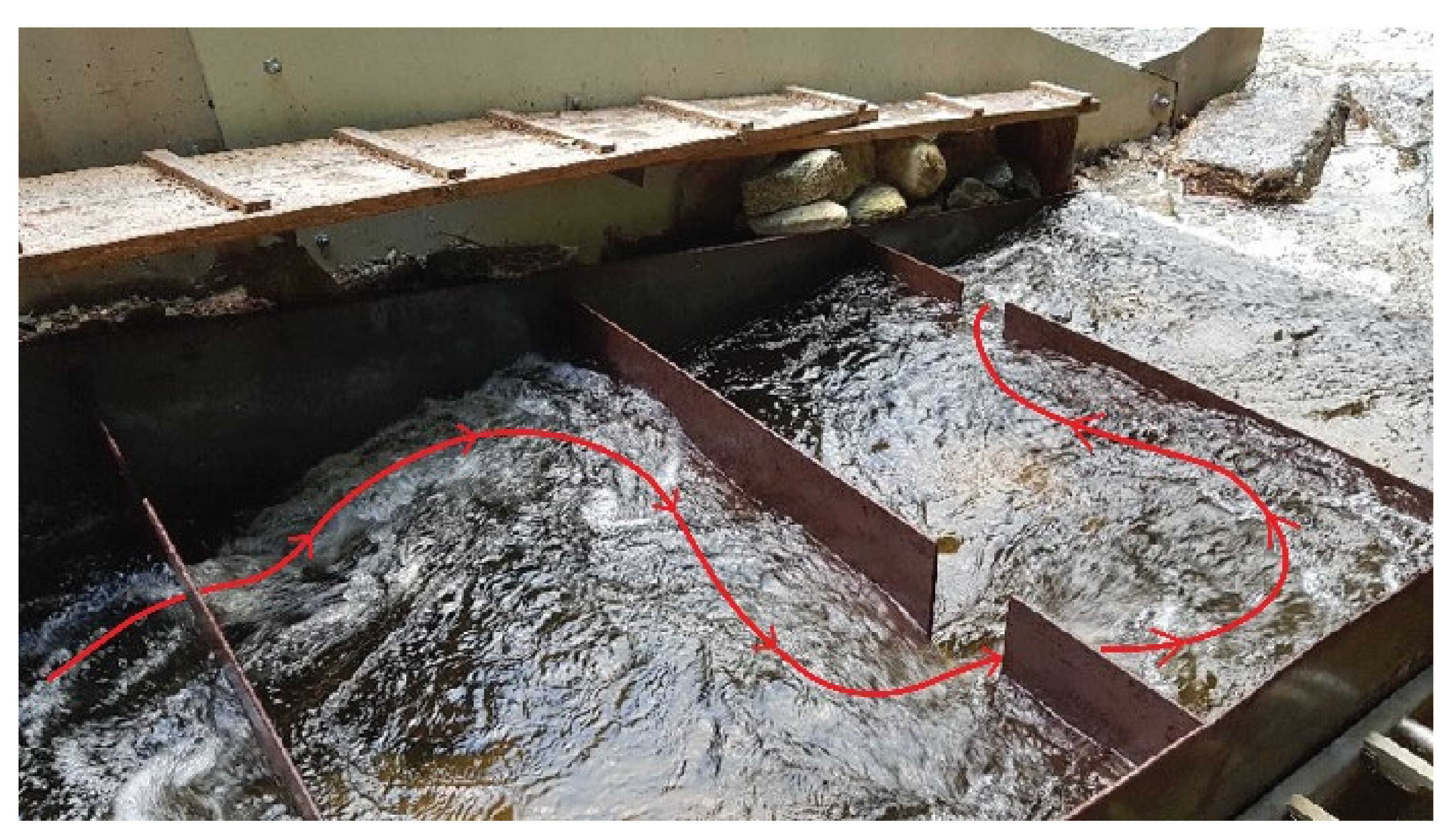
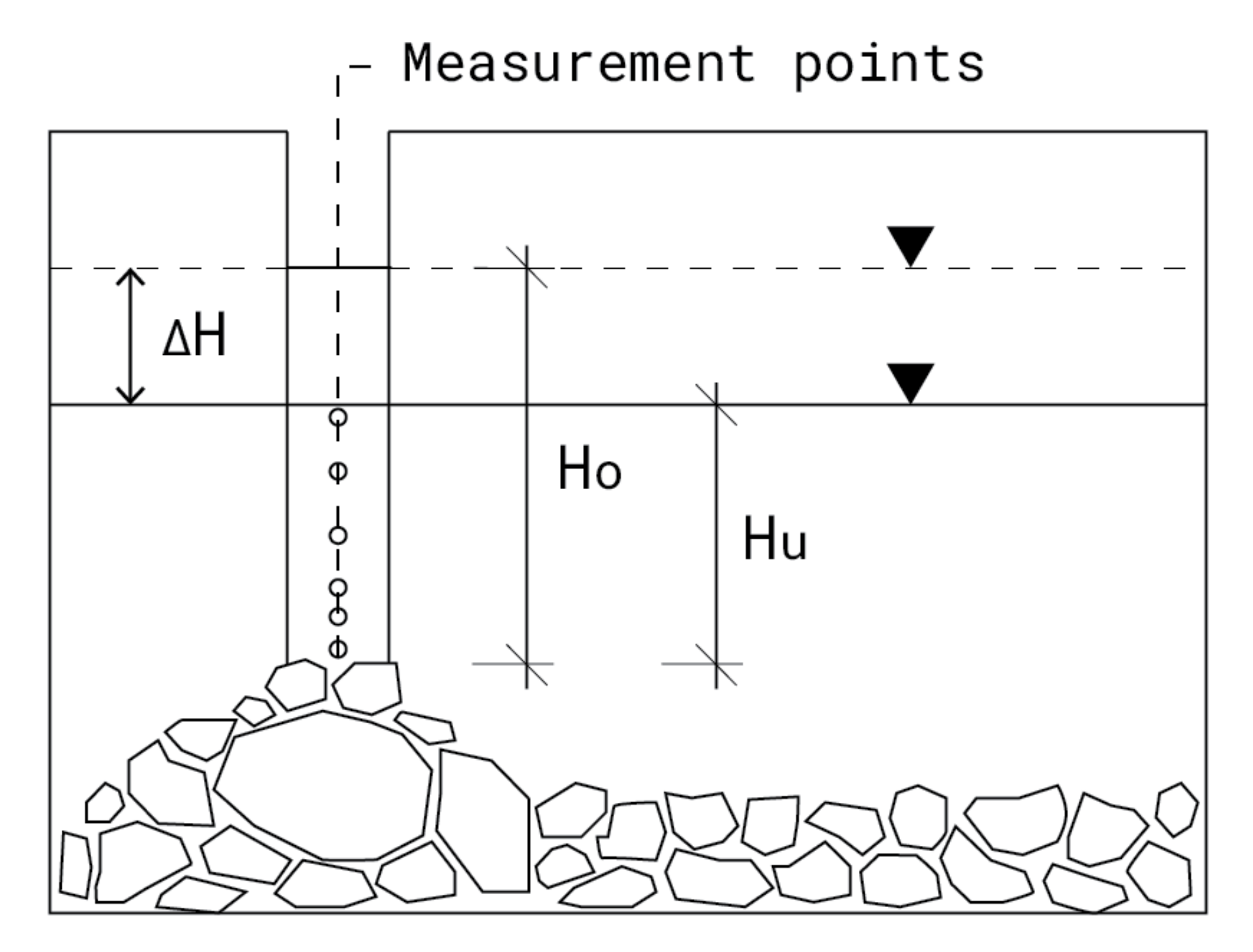
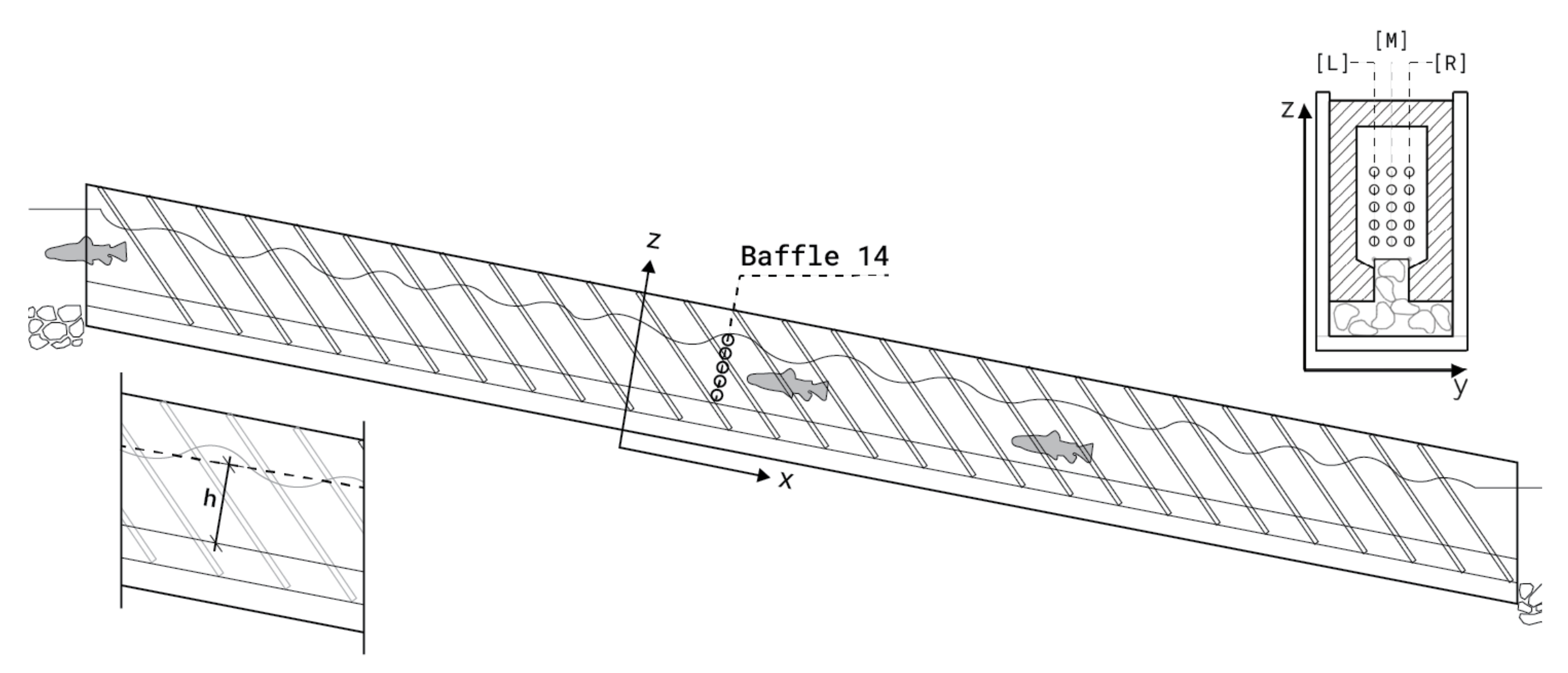

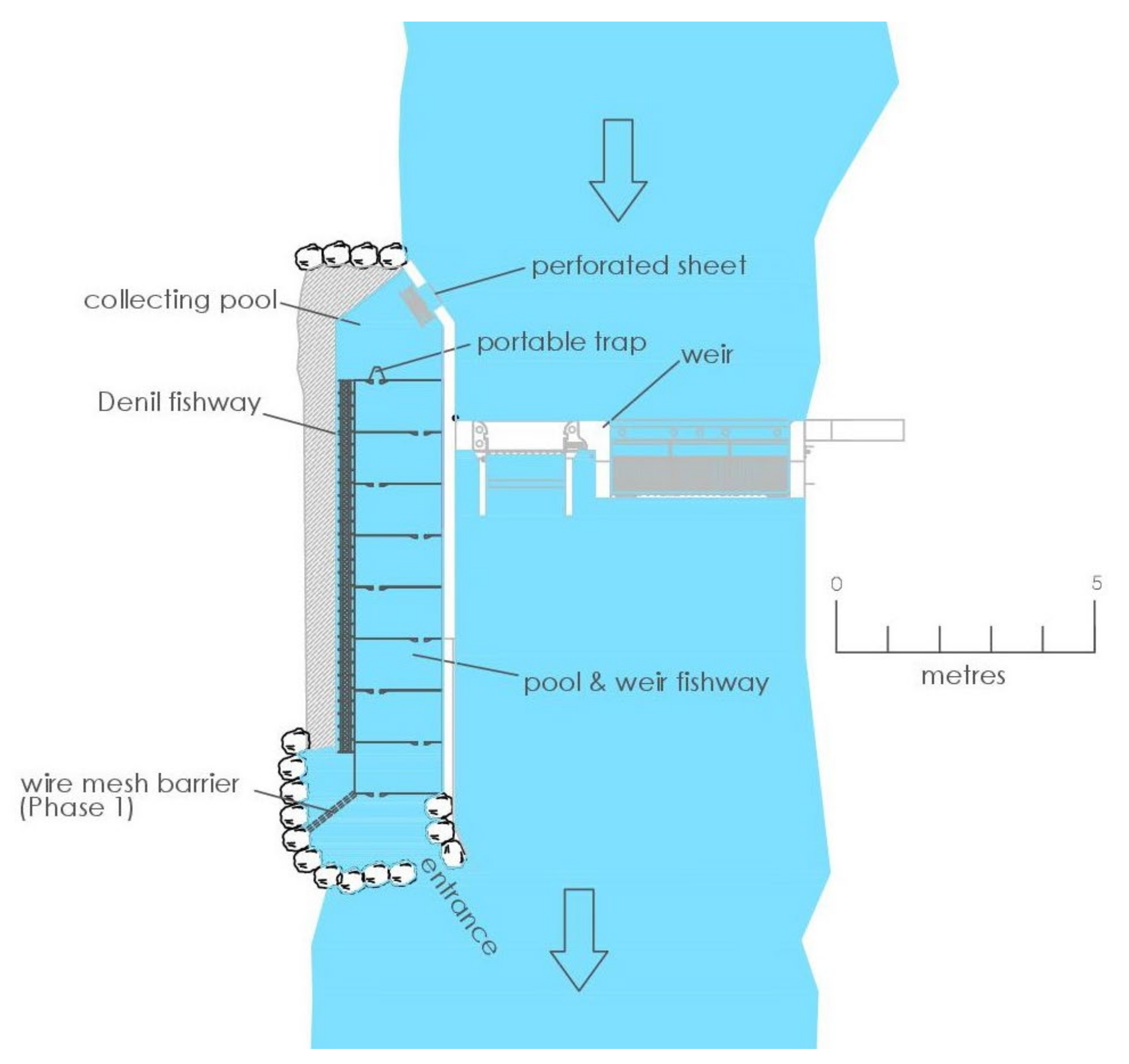
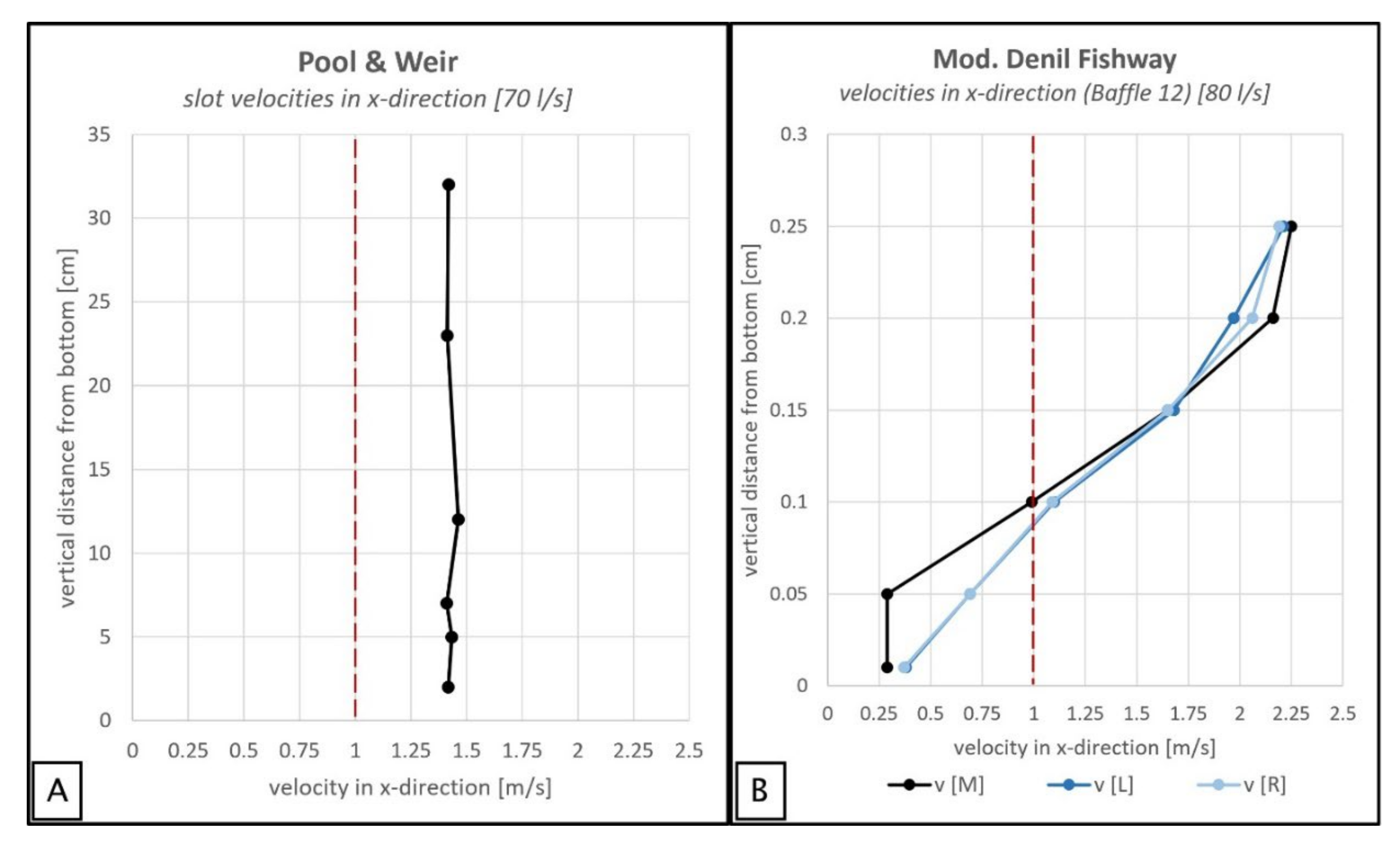
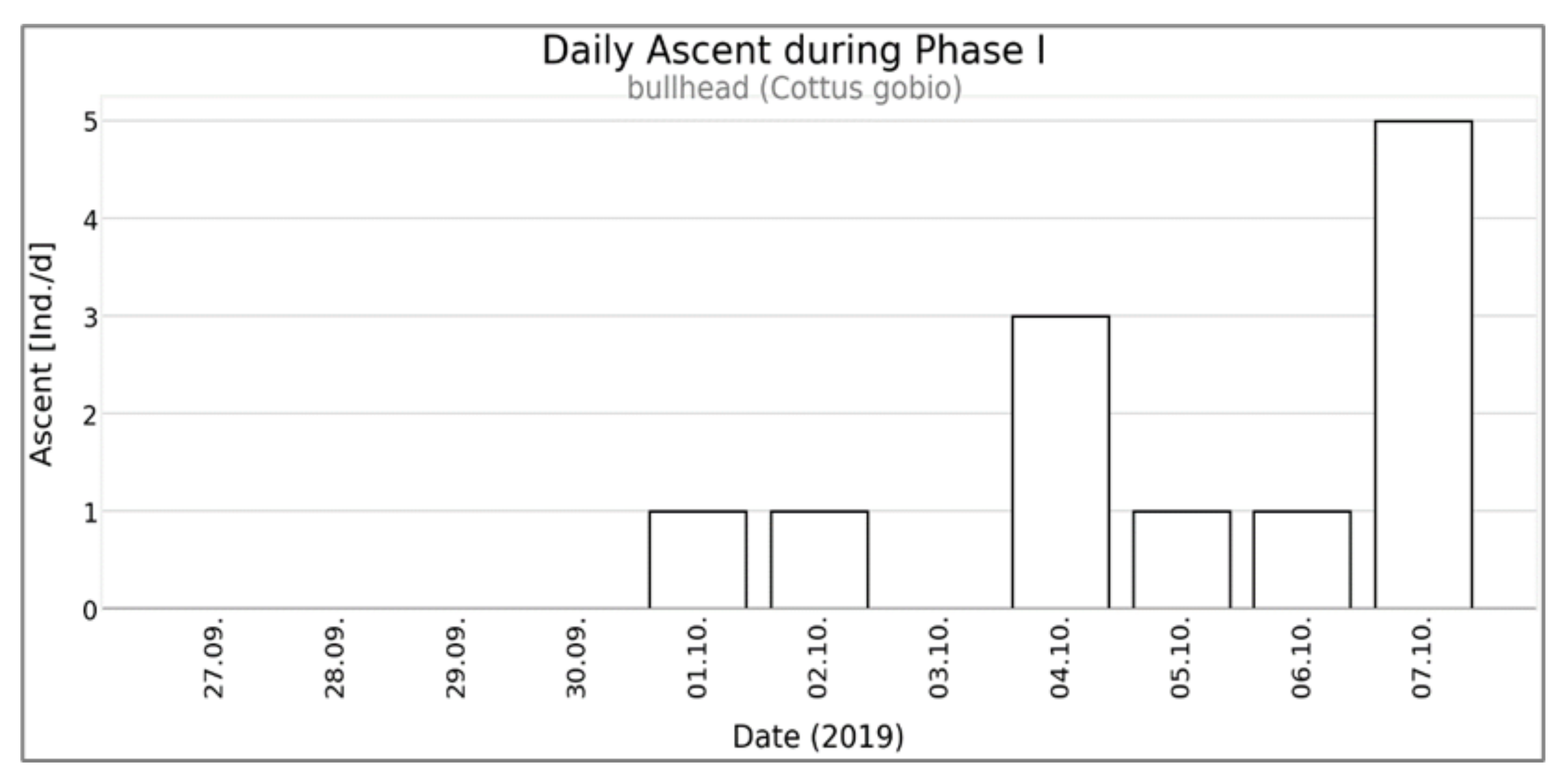
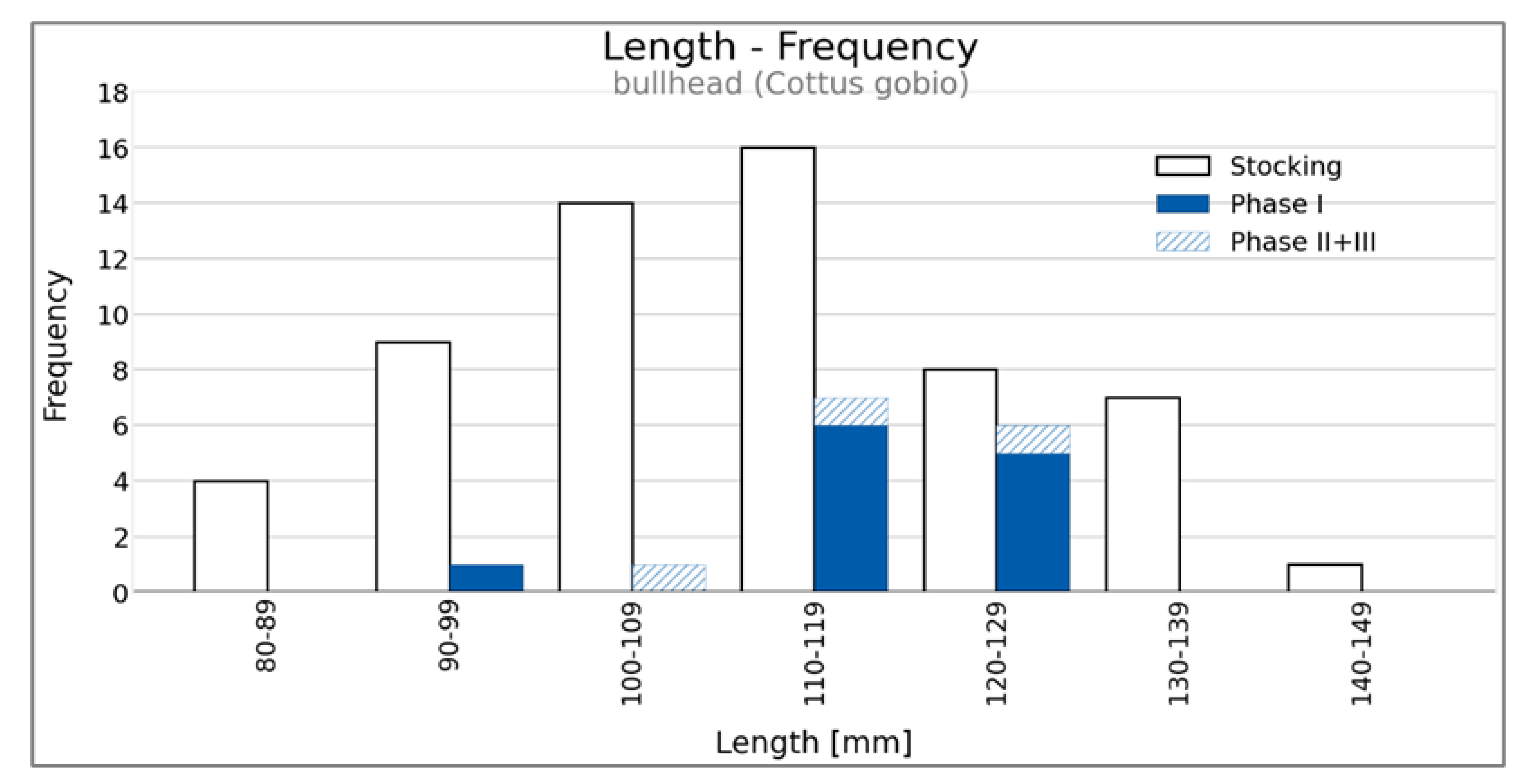
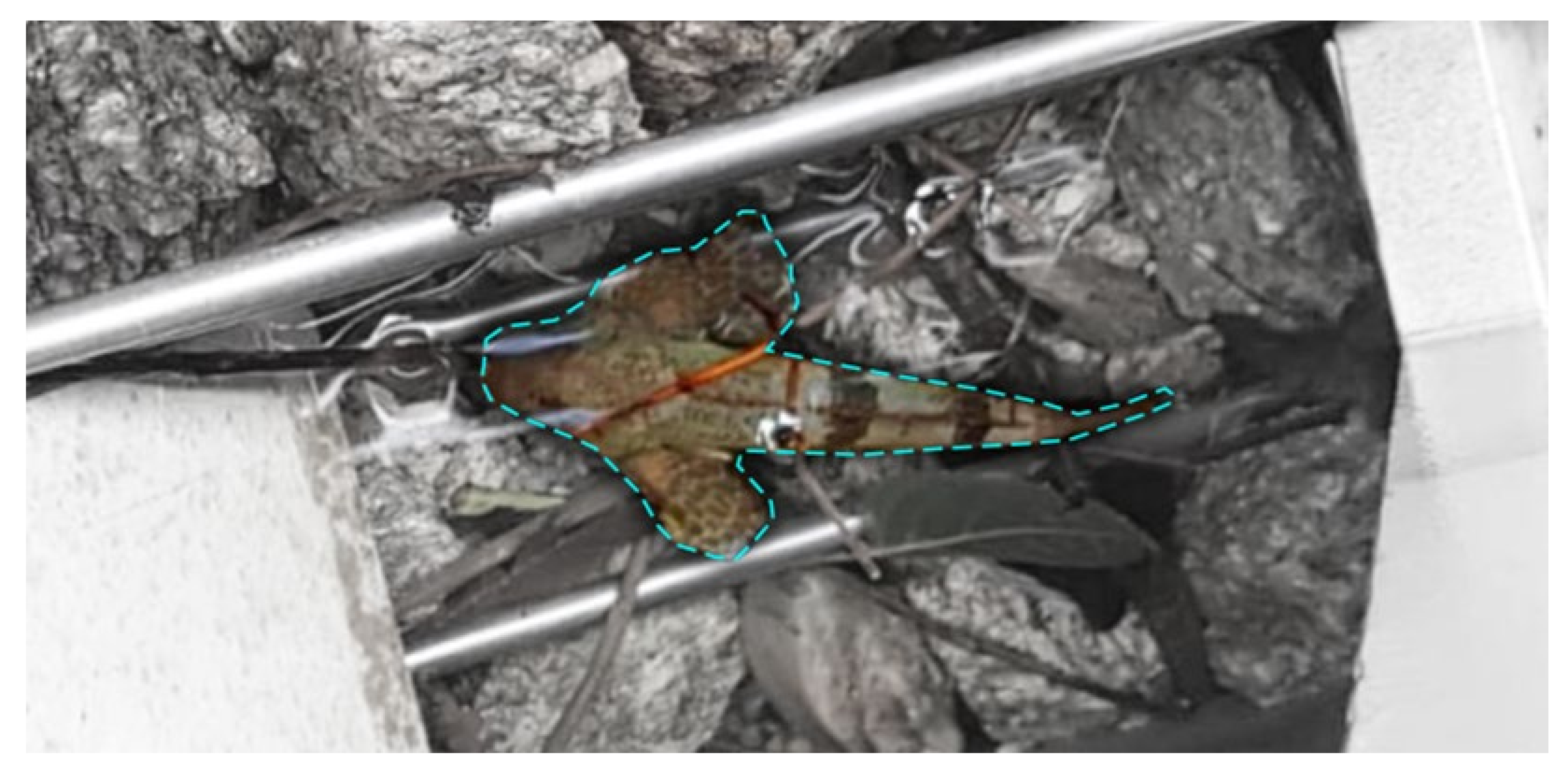
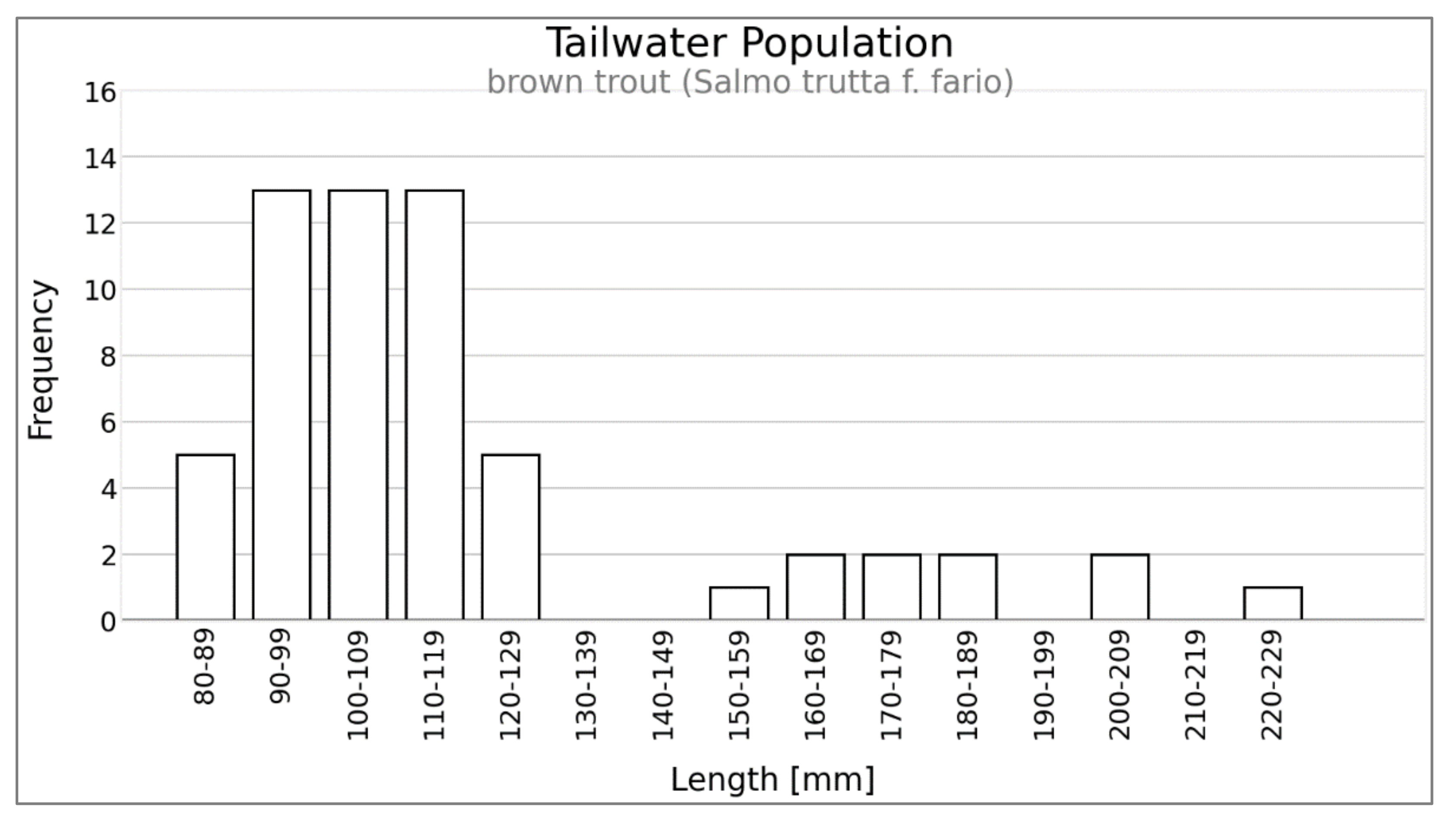
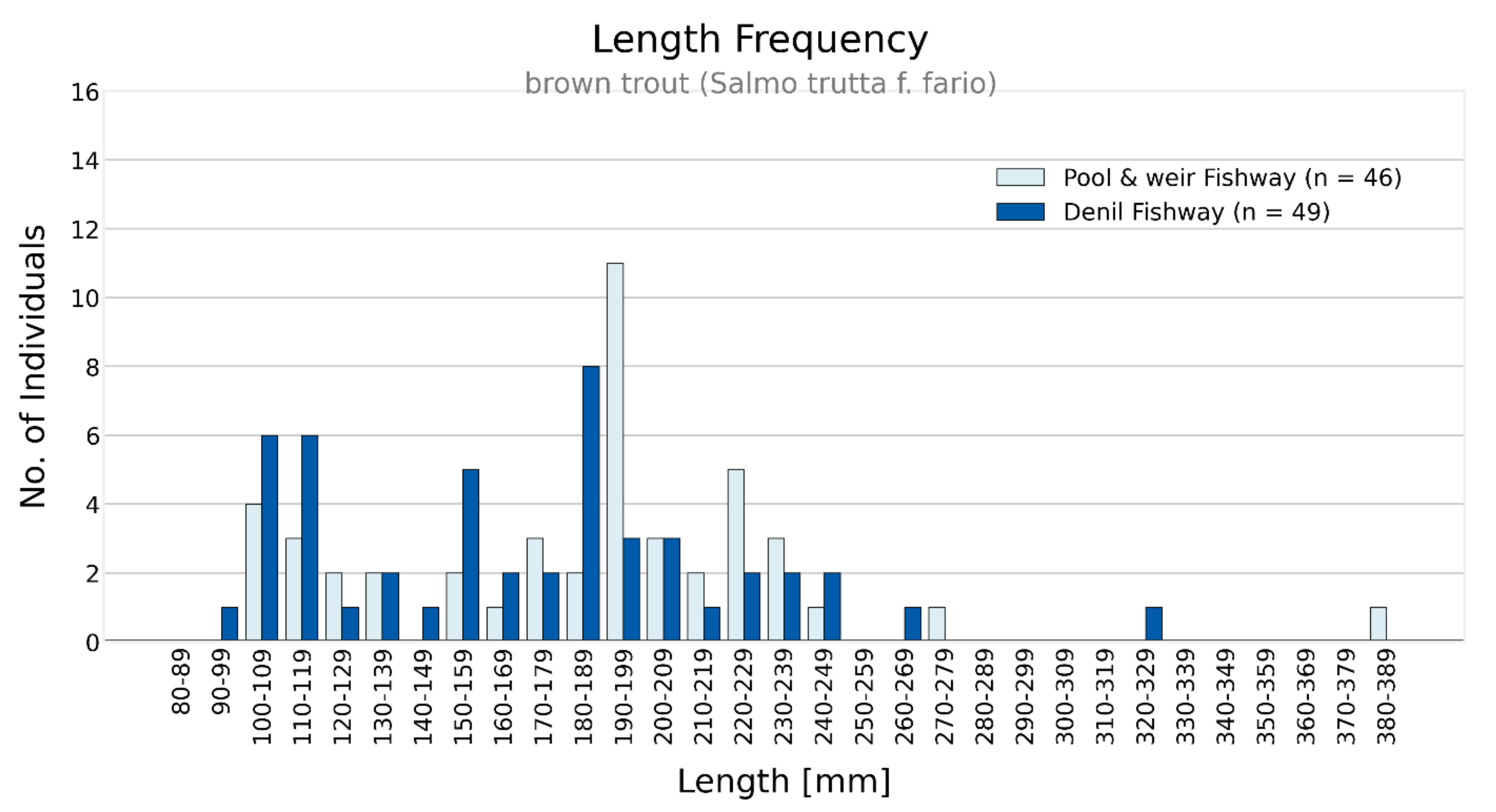

| Hydrological Parameter | Unit | Value |
|---|---|---|
| Catchment area | [km2] | 22 |
| Mean discharge | [l/s] | 343 |
| Mean annual low discharge | [l/s] | 130 |
| Lowest discharge | [l/s] | 66 |
| Fishway | Brown Trout | ||||
|---|---|---|---|---|---|
| ∑ | Individuals/day | ||||
| Min | Mean | Max | SD | ||
| Denil | 49 | 0 | 4 | 9 | 3.3 |
| Pool and weir | 46 | 0 | 4 | 18 | 4.5 |
| Phase II | 46 | 0 | 4 | 9.0 | 3.1 |
| Phase III | 49 | 0 | 5 | 18.0 | 4.9 |
| Fishway | ∑ | Fork Length (mm) | |||
| Min | Mean | Max | SD | ||
| Denil | 49 | 95 | 166 | 320 | 54.6 |
| Pool and weir | 46 | 100 | 183 | 380 | 42.8 |
Disclaimer/Publisher’s Note: The statements, opinions and data contained in all publications are solely those of the individual author(s) and contributor(s) and not of MDPI and/or the editor(s). MDPI and/or the editor(s) disclaim responsibility for any injury to people or property resulting from any ideas, methods, instructions or products referred to in the content. |
© 2023 by the authors. Licensee MDPI, Basel, Switzerland. This article is an open access article distributed under the terms and conditions of the Creative Commons Attribution (CC BY) license (https://creativecommons.org/licenses/by/4.0/).
Share and Cite
Seidl, G.; Schneider, J. Comparative Biotic Monitoring of a Modified Denil Fishway and a Pool and Weir Fishway on a Small Tributary in the Upper Trout Region. Water 2023, 15, 2322. https://doi.org/10.3390/w15132322
Seidl G, Schneider J. Comparative Biotic Monitoring of a Modified Denil Fishway and a Pool and Weir Fishway on a Small Tributary in the Upper Trout Region. Water. 2023; 15(13):2322. https://doi.org/10.3390/w15132322
Chicago/Turabian StyleSeidl, Georg, and Josef Schneider. 2023. "Comparative Biotic Monitoring of a Modified Denil Fishway and a Pool and Weir Fishway on a Small Tributary in the Upper Trout Region" Water 15, no. 13: 2322. https://doi.org/10.3390/w15132322
APA StyleSeidl, G., & Schneider, J. (2023). Comparative Biotic Monitoring of a Modified Denil Fishway and a Pool and Weir Fishway on a Small Tributary in the Upper Trout Region. Water, 15(13), 2322. https://doi.org/10.3390/w15132322






